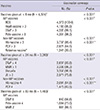Abstract
Figures and Tables
Fig. 1

Table 1

*Doses for rotavirus vaccine include 2 doses for Rotarix and 3 doses for RotaTeq; †Candidates for 'Vaccines given ≤ 6 mo' include children aged 7-83 months (n = 4,374); 'Vaccines given ≤ 24 mo' include children aged 19-83 months (n = 3,393); 'Vaccines given ≤ 83 mo' include children aged 54-83 months (n = 1,483); §Significant difference in the coverage between 'Vaccines given ≤ 6 mo', 'Vaccines given ≤ 23 mo', and 'Vaccines given ≤ 83 mo'; ¶Significant difference in the coverage between NIP vaccines vs non-NIP vaccines; **Significant difference in the coverage between Hib vaccine vs PCV; and/or Hib vaccine vs rotavirus vaccine. NIP, National Immunization Program; BCG, Bacillus Calmette-Guerin vaccine; HepB, hepatitis B; DTaP, diphtheria, tetanus toxoids, and acellular pertussis vaccine; Hib, Haemophilus influenzae type b; PCV, pneumococcal conjugate vaccine; MMR, measles, mumps and rubella vaccine; JE, Japanese encephalitis.
Table 2

*Metropolitan cities include Busan, Daegu, Incheon, Daejeon, Ulsan and Gwangju; Others include Gangwon, Chungbuk, Chungnam, Jeonbuk, Jeonnam, Gyeongbuk, Gyeongnam and Jeju provinces; †Doses for rotavirus vaccine include 2 doses for Rotarix and 3 doses for RotaTeq; §Significant difference in the coverage between Others vs Seoul; Others vs Metropolitan cities; and Others vs Gyeonggi Province. NIP, National Immunization Program; DTaP, diphtheria, tetanus toxoids, and acellular pertussis vaccine; Hib, Haemophilus influenzae type b; PCV, pneumococcal conjugate vaccine.
Table 3

*≥ 3 doses for Hib vaccine and PCV; ≥ 2 doses for Rotarix and ≥ 3 doses for RotaTeq. †Significantly lower (higher for education) coverage than the comparing group on univariate analysis (P < 0.001). §Significantly lower coverage than the comparing group on multivariate analysis (P < 0.001). CI, confidence interval; OR, odds ratio; Hib, Haemophilus influenzae type b; PCV, pneumococcal conjugate vaccine; BM, breast milk.




 PDF
PDF ePub
ePub Citation
Citation Print
Print


 XML Download
XML Download